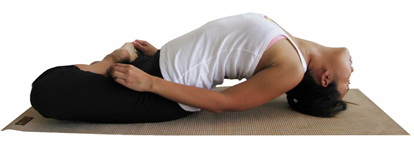The Matsyasana is typically used as a counterpose for Salamba Sarvangasana (Supported Shoulder Stand), a pose whereby the back of your neck muscles and upper spine are stretched. On the other hand, the Matsyasana, stretches the front part of the neck, opens up the throat and compresses the upper spine. For many of us who spend most of our time hunched over the computer, this pose improves the posture and increases lung capacity.
There is a common inclination towards placing the entire weight of your upper body on the crown of your head as you arch your back into postion. Instead, you should continue to open up your chest by moving your shoulders back and transfer your upper body weight back down to the center of your abdomen.
There are a few variations in Matsyasana. Traditionally it is performed with your legs in Padmasana.

Or as a beginner both feet are placed together on the ground.

In the finishing sequence of Ashtanga, the Extended Fish Pose (Uttana Padasana) is performed. In this variation, both legs are raised 45 degrees from the floor and the arms extended forward with fingers pointing towards the ceiling.

My yoga teacher once told me that one can float by performing the Matyasana in water. I was sceptical at first but tried it out of curiosity, and surprisingly it worked!